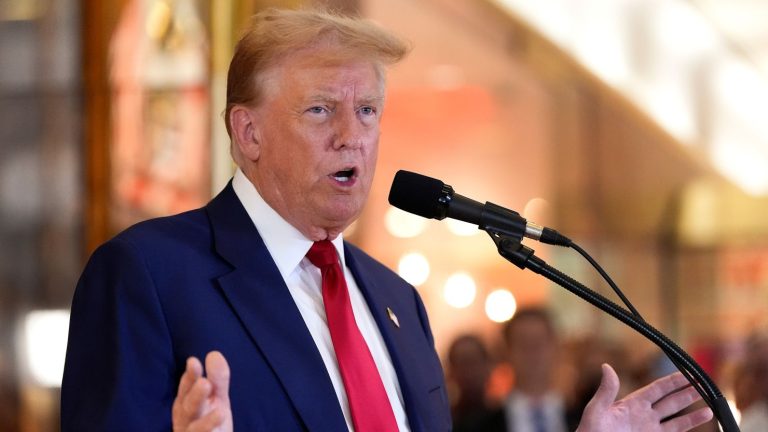Countries worldwide threatened to escalate a trade war with the United States after President Donald Trump’s sweeping tariffs sparked fears of rising prices in the world’s largest consumer market and a potential global economic downturn.
Trump’s announcement on Wednesday sent global financial markets into a tailspin and drew condemnation from leaders grappling with the collapse of decades-long trade liberalization efforts. However, conflicting signals emerged from the White House regarding whether the tariffs were meant to be permanent or merely a negotiation tactic. Trump insisted they “give us great power to negotiate.”
The newly imposed U.S. tariffs represent the highest trade barriers in over a century, starting with a 10% baseline tariff on all imports and higher targeted duties on key trading partners. This could significantly increase prices for American consumers on everything from cannabis to running shoes—and even Apple’s iPhones. Analysts at Rosenblatt Securities estimate that a high-end iPhone could cost nearly $2,300 if Apple passes the additional costs on to customers.
Businesses scrambled to adapt. Automaker Stellantis announced temporary layoffs of U.S. workers and plant closures in Canada and Mexico, while General Motors (GM.N) pledged to increase domestic production. Investment bank JPMorgan revised its global recession probability to 60%, up from 40%, citing the tariffs’ economic impact.
Canadian Prime Minister Mark Carney criticized the United States for abandoning its historical role as a leader in international economic cooperation. “The global economy is fundamentally different today than it was yesterday,” he said while unveiling limited countermeasures. Meanwhile, China vowed to retaliate against Trump’s 54% tariffs on its exports, and the European Union, facing a 20% duty, signaled a similar response. French President Emmanuel Macron urged European nations to suspend investments in the U.S.
Other major trading partners—including Japan, South Korea, Mexico, and India—held off immediate retaliation, opting instead to seek concessions. Despite widespread warnings of a severe blow to global trade, Washington remained steadfast. Japanese Prime Minister Shigeru Ishiba called the situation a “national crisis,” while IMF Managing Director Kristalina Georgieva urged the U.S. and its partners to resolve trade tensions, warning that the tariffs posed a significant risk to an already fragile global economy.
Adding to the uncertainty, U.S. Commerce Secretary Howard Lutnick and trade adviser Peter Navarro insisted on Thursday that the tariffs were non-negotiable. However, Trump appeared to contradict them, telling reporters, “The tariffs give us great power to negotiate. Always have. I used it very well in the first administration, as you saw, but now we’re taking it to a whole new level.”
Financial markets suffered a global meltdown in response. The U.S. dollar weakened, oil prices faced their worst decline in months, and stocks plunged. The Dow (.DJI) fell nearly 4%, its worst one-day percentage drop since June 2020, while the S&P 500 (.SPX) lost almost 5%, and the Nasdaq (.IXIC) tumbled nearly 6%, marking its worst day since the early pandemic era of March 2020.
American companies with significant overseas manufacturing bore the brunt of the turmoil. Nike (NKE.N) shares plunged 14%, and Apple (AAPL.O) lost 9%. The selloff continued into Friday, with Japan’s Nikkei (.N225) on track for its worst weekly drop in five years, driven by a banking stock rout. Japanese bond yields also fell sharply, as investors speculated that the Bank of Japan might reconsider its plans to raise interest rates.
Trump defended the tariffs as “reciprocal” measures against trade barriers imposed on U.S. goods. Administration officials argued that the move would create manufacturing jobs and open new export markets, though they cautioned that results would take time. Vice President JD Vance dismissed critics for their short-term outlook, stating, “This is fundamentally about the national security of manufacturing—making the things we need, from steel to pharmaceuticals.”
Since Trump’s return to the White House in January, his on-again, off-again tariff threats have unsettled consumer and business confidence. With the new tariffs set to take effect on April 9, there remains a possibility he could walk them back. However, analysts argue that the plan lacks strategic depth. James Lucier, a founding partner at Capital Alpha, remarked, “The tariff plan does not appear to be well thought-out. Trade negotiations are a highly technical discipline, and these proposals do not offer a serious basis for discussions with any country.”
Economists warn that the tariffs could stoke inflation, raise the risk of a U.S. recession, and increase costs for the average American household by thousands of dollars. Additionally, they could alienate key allies in Asia and complicate U.S. efforts to counter China’s influence.
Trump has imposed a 24% tariff on Japan, 25% on South Korea, and 32% on Taiwan, even as Taiwan faces heightened military pressure from China. While Canada and Mexico were spared targeted tariffs in Wednesday’s announcement, they are already subject to 25% duties on many goods and now face additional levies on auto imports.
As global leaders weigh their next moves, the fallout from Trump’s trade policies continues to ripple across markets, businesses, and diplomatic relations.

